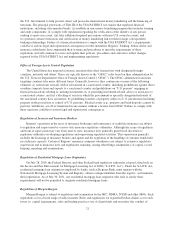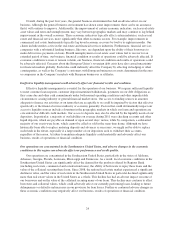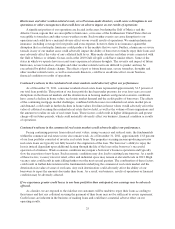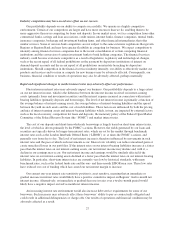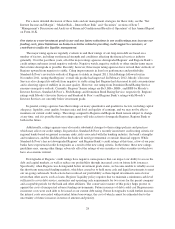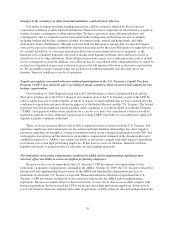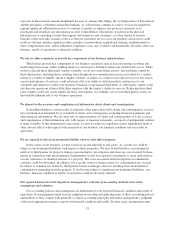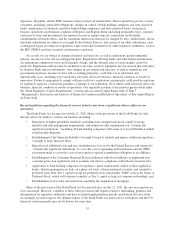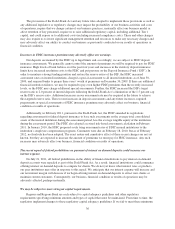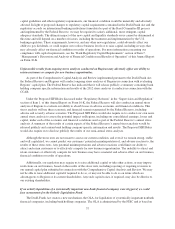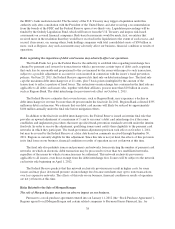Regions Bank 2011 Annual Report Download - page 53
Download and view the complete annual report
Please find page 53 of the 2011 Regions Bank annual report below. You can navigate through the pages in the report by either clicking on the pages listed below, or by using the keyword search tool below to find specific information within the annual report.Additionally, at the time Regions was downgraded to below investment grade, certain counterparty contracts
were required to be renegotiated, resulting in additional collateral postings of approximately $200 million. Refer
to Note 20, “Derivative Financial Instruments and Hedging Activities, Contingent Features” to the consolidated
financial statements of this Annual Report on Form 10-K for the fair value of contracts subject to contingent
credit features and the collateral postings associated with such contracts. Future downgrades could require
Regions to post additional collateral. While the exact amount of additional collateral is unknown, it is reasonable
to conclude that Regions may be required to post approximately an additional $200 million related to existing
contracts with contingent credit features. Additionally, if due to future downgrades, we were required to cancel
our derivatives contracts with certain counterparties and were unable to replace such contracts, our market risk
profile could be altered. Regions believes that this market risk exposure would be immaterial to its consolidated
financial position, liquidity and results of operations.
The value of our goodwill and other intangible assets may decline in the future.
As of December 31, 2011, we had $4.8 billion of goodwill and $449 million of other intangible assets. A
significant decline in our expected future cash flows, a significant adverse change in the business climate, slower
growth rates or a significant and sustained decline in the price of our common stock, any or all of which could be
materially impacted by many of the risk factors discussed herein, may necessitate our taking charges in the future
related to the impairment of our goodwill. Future regulatory actions could also have a material impact on
assessments of goodwill for impairment. If the fair value of our net assets improves at a faster rate than the
market value of our Banking/Treasury reporting unit, we may also have to take charges related to the impairment
of our goodwill. If we were to conclude that a future write-down of our goodwill and other intangible assets is
necessary, we would record the appropriate charge, which could have a material adverse effect on our results of
operations.
Additionally, as a result of the potential sale of Morgan Keegan, Regions is evaluating the organization of
its reporting units. Reorganization of its reporting units in the future would result in a reallocation of goodwill
across Regions’ business, at which time Regions would be required to test its goodwill in these new reporting
units for impairment and could result in a write-down of our goodwill. A goodwill impairment charge is a
non-cash item that does not have an adverse impact on regulatory capital.
The value of our deferred tax assets could adversely affect our operating results and regulatory capital ratios.
As of December 31, 2011, Regions had approximately $1.3 billion in net deferred tax assets, of which $432
million was disallowed when calculating regulatory capital. Applicable banking regulations permit us to include
these deferred tax assets, up to a maximum amount, when calculating Regions’ regulatory capital to the extent
these assets will be realized based on future projected earnings within one year of the report date. The ability to
realize these deferred tax assets during any year also includes the ability to apply these assets to offset any
taxable income during the two previous years. Unless we anticipate generating sufficient taxable income in the
future, we may be unable to include additional amounts related to our deferred tax assets as part of our regulatory
capital. The inability to include deferred tax assets in our regulatory capital could significantly reduce our
regulatory capital ratios.
Additionally, our deferred tax assets are subject to an evaluation of whether it is more likely than not that
they will be realized for financial statement purposes. In making this determination, we consider all positive and
negative evidence available including the impact of recent operating results as well as potential carryback of tax
to prior years’ taxable income, reversals of existing taxable temporary differences, tax planning strategies and
projected earnings within the statutory tax loss carryover period. We have determined that the deferred tax assets
are more likely than not to be realized at December 31, 2011 (except for $32 million related to state deferred tax
assets for which we have established a valuation allowance). If we were to conclude that a significant portion of
our deferred tax assets were not more likely than not to be realized, the required valuation allowance could
adversely affect our financial position and results of operations.
29




